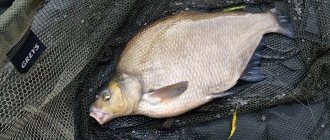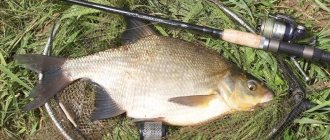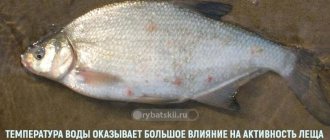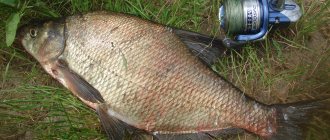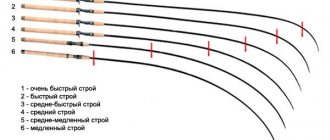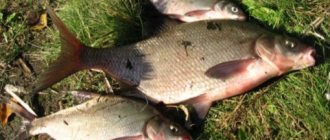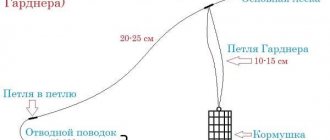- Groundbaits
14658
The shelves of fishing stores are filled with industrial bait mixtures, but, according to many feeder fishing enthusiasts, a good half of them are inferior in effectiveness to the so-called Salapin feeder porridge. In addition, salapinka, as fishermen often affectionately call it, can be easily prepared at home by purchasing all the necessary ingredients at the nearest supermarket. If we talk about cost, this is perhaps the most budget-friendly bait option. The only thing that is cheaper than this is makha, which can be used without mixing it with anything. But will the result be the same as with the salapina? Hardly.
So, everything you need to prepare a simple but very effective porridge can be found in the first grocery store you come across. In this case, the entire set will cost a maximum of 15-20 rubles. For comparison, let’s name a couple of store-bought formulations in the mid-price category. Take, for example, carp Traper or GF. For a kilogram package of each of them you will have to pay at least 150 rubles. As you can see, the difference is more than significant.
Despite the cheapness, Salapin porridge for feeders, or rather its working qualities, evoke real admiration. Once in the water, this bait creates an attractive cloud of turbidity around the feeder; large components disintegrate gradually, so the fish are not oversaturated. Salapina is good not only for feeder fishing with classic feeder feeders, it can also be used in other types of fishing. For example, for such gear as a crucian carp killer, in which springs serve as feeders. Or when fishing with a fly rod, periodically throwing compressed lumps of porridge to the fishing point. The only thing she is not “friendly” with is a strong current. A powerful stream washes it out of the feeder too quickly. There are two ways to combat this: use a design with a small mesh and pack the food more densely.
How to feed bream according to the seasons
In the natural environment, the nutritional needs of fish change with changing environmental conditions. Therefore, the composition and even the color of bait for bream differs depending on the season. Fish react much more actively to food that is close to its diet in real conditions.
In summer
- The best bait for bream in the summer on the current is a mixture of cake, breadcrumbs, sprouted peas, oatmeal and 2 teaspoons of ground coriander. With the exception of the last ingredient, all components of the recipe are taken in equal proportions. For better viscosity of the composition, add a little clay to it. The finished porridge is rolled into small balls and thrown into the intended fishing areas.
- For summer fishing in reservoirs with stagnant water, a different recipe is used. Millet cereal is boiled until half cooked and the same amount of bran is added to it. Then breadcrumbs and toasted sunflower seeds are added to the mixture, as well as a little cinnamon and coriander - bream love the smell of these spices. On the shore, clay or soil is added to the mixture to give the desired consistency.

in autumn
The fall bait recipe for bream includes boiled rice, cake, breadcrumbs, bran, finely chopped lard, as well as worms or maggots. All ingredients are mixed in equal proportions, and a small amount of coriander is added as a flavoring. The composition of this supplement for bream is quite nutritious, since in autumn the fish require more calories for normal survival in conditions of decreasing temperatures.

Read: Bream fishing in autumn
in winter
Bait for bream in winter is prepared like this. Peas, corn, hemp, peanuts and buckwheat are fried in a frying pan. When frying, you need to constantly stir the grains - it is important that they acquire aroma, but do not burn. After frying, the ingredients are ground in a meat grinder. The finished mixture is mixed with breadcrumbs, bran, coconut flakes, and a pinch of salt. The flavors in this recipe are cinnamon, cocoa, dried dill. You can use such mixtures by adding small parts of water and forming small balls.
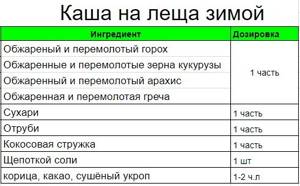
in spring
In spring, the secrets of bream bait recipes are hidden in the content of the animal component in the feed. The best choice for spring is a mixture of sunflower cake, boiled millet, fried bran, bloodworms and coriander to enhance the aroma.

Making your own bait
The best mass is the one prepared with your own hands by a fisherman who knows all the intricacies of the reservoir and, when preparing, takes into account the current, type of reservoir and time of year.
So, to prepare bream’s favorite food, no special steps are required, since there are a huge number of recipes for the mass and choosing the most suitable one for all requirements will not be difficult.
Recipe No. 1 (summer on still water)
For each season, a different recipe has been developed for catching bream, which satisfies all the taste requirements of this variety. The recipe below is ideal for summer fishing in still water.
And here's what you need to know: Do-it-yourself bait for crucian carp. Super catchy bait!
Preparing a nutritious dish does not cause even the slightest difficulty; you just need to choose the right ingredients, avoid making mistakes in proportions and make a porridge so dear to the heart of bream.
For the feeder
Preparing bait at home is especially important for catching large bream. It is also advisable to use a feeder, since large fish are found at depth and are almost impossible to catch from the shore.
One of the popular homemade bait recipes is Salapin porridge for a bream feeder. It includes:
- pearl barley (1 part);
- millet (2 parts);
- corn and barley grits (2 parts each);
- a bag of vanilla sugar;
- a tablespoon of unrefined vegetable oil;
- water: 9 parts.
Water is poured into the pan and brought to a boil. The washed pearl barley is poured into it and cooked until half cooked (about 15-30 minutes). Oil and vanilla sugar are added to the mixture, and then millet is added. When the water begins to noticeably decrease, turn off the heat and cover the pan with a lid.
Barley and corn grits are mixed in a separate container. Then the dry mixture is mixed with millet-pearl porridge while the latter is still hot. The container with the entire mixture is placed on a cooling burner so that the ingredients are better soaked.
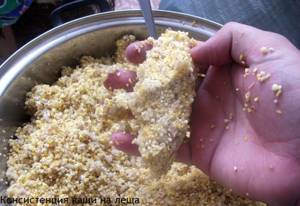
If desired, the recipe can be modified; additional aromatic substances and ingredients can be introduced depending on the season and the personal experience of the fisherman.
Read: Recipe for Salapin porridge
How much porridge should I add to the bait?
Everything is clear with the addition. It can make up up to half the volume of the feeder (usually 20-30%) and will keep the fish in one place. Here the fear arises not of feeding, but of overfeeding the fish. Indeed, if there is no current or there are not many fish in the reservoir, then such a possibility exists. But when fishing with a feeder on a river, especially if it has a good full-flowing bed, such fears are unnecessary. Usually on the river the fish are very active and constantly move in search of food. The current constantly washes away our bait table for fish. Under such conditions, the use of “heavy” pieces of porridge will be simply necessary.
Of course, only the base without additives can be used as bait for the feeder, especially since it is sold in every fishing store and can be prepared in a few minutes. Many people do this and are successful. But everything, again, depends on the fishing conditions, the size of the fish being fed and the strength of the current. It’s one thing to feed roach, but quite another to feed non-protocol bream or even carp. The base attracts fish and does it well. But keeping, for example, a school of bream in one place will only be possible with the use of an additive.
Required Ingredients
Bream is a fairly large fish, so large feed fractions are relevant for catching it. The main nutritional ingredients in homemade bait for bream are millet and pearl barley. In summer, other products are introduced as the main ingredients; sweet corn, green peas, and small boilies are used as bait.
Read: Making boilies for fishing
In the cold season, it is better to use food of animal origin as the main component - maggots, chopped earthworms, bloodworms. The presence of an animal component is mandatory for bait in cold water, since during this period the bream feeds exclusively on animal food.
Winter bait recipe
If we talk directly about the baits themselves, then when preparing them there are several basic rules:
- Winter bait must contain bloodworms, jigs or other animal components in a proportion of 25 - 50 g per 500 g of plant components;
- All plant components must be thoroughly crushed so that they spread as far as possible, attracting fish, and do not allow the fish to get enough of them;
- Flavors should be added in reasonable quantities so that they attract and not repel fish;
- In different bodies of water, the smells that attract fish are different, you need to try;
- The calorie content of the feed should correspond to the activity of the fish in a given period;
- The soil is placed if it contains bloodworms and similar animal additives;
- The main difference between winter baits is that most of them do not contain binding components.
- The winter baits themselves are quite varied; let’s look at some of the most common, “folk” recipes.
Groundbait based on peas
As you know, peas are one of the favorite baits of bream.
Ingredients:
- breadcrumbs (ordinary grated ones can be used) – 500 g;
- roasted sunflower seeds – 75 g;
- oat flakes – 100 g;
- crushed polished peas – 250 g;
- bloodworm 50 – 100 g.
Pour water into the pan in the proportion of two glasses of water per glass of peas. When the water boils, add the peas and cook over low heat until they are cooked into a homogeneous mass. Finely grind crackers, oatmeal and seeds in a meat grinder or coffee grinder.
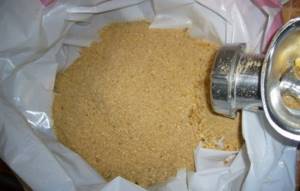
Mix the ground seeds, crackers and flakes in a bowl, and then pour them with boiled pea porridge.
Knead the resulting mixture with your hands until smooth and transfer it to a plastic bag. The resulting bait should form a lump and disintegrate easily; when it gets into the water, it gives a good cloud of turbidity that attracts fish.
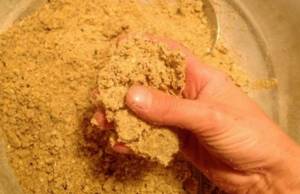
Directly while fishing, add bloodworms to the mixture.
Classic bait
The second recipe contains, classic for bream, millet and crackers.
Ingredients:
- millet – 500 g;
- bread crumbs, regular or bread crumbs - 300 g;
- fried sunflower seeds – 100 g;
- sunflower oil – 50 g;
- bloodworm – 150 – 200 g.
Cook the millet in a 1:2 ratio with water until the water has completely boiled away. We pass the crackers through a meat grinder, and then fry the resulting crumbs in sunflower oil. We also pass the seeds through a meat grinder. Mix all ingredients in a bowl or immediately in a thick plastic bag. Already while fishing, we add small or chopped large bloodworms to the mixture.
Video recipe: Bait made from pearl barley and millet
Fragrant bait
The flavor components that will play an important role in this recipe are hemp, coriander and anise. Ingredients:
- crackers (they can be replaced with biscuits) – 400 g;
- semolina – 100 g;
- bran or birdseed – 350 g;
- hemp seeds – 50 g;
- a little anise or coriander
- bloodworms or maggots – 30 – 70 g.
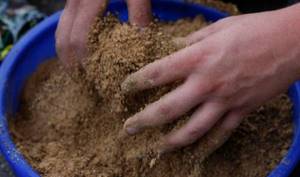
We prepare all the ingredients at home. We roast hemp seeds, add them to crackers or cookies and grind them in a meat grinder along with bran or birdseed. Grind the semolina in a blender. Mix it all dry, adding anise or coriander. The final preparation of the mixture is done while fishing. Add a little water to the bait until you get a consistency that matches the fishing conditions. At the very end, add bloodworms.
Universal bait
This bait is notable because it is suitable not only for bream, but also for roach and other white fish.
Ingredients:
- corn flour – 200 g
- breadcrumbs or regular crackers - 250 g;
- peas – 150 g;
- buckwheat – 150 g;
- pearl barley – 100 g;
- hemp grains – 50 g.
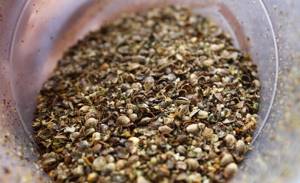
Hemp grains, as well as buckwheat and pearl barley, are fried and passed through a meat grinder a couple of times along with breadcrumbs. The peas are boiled until smooth or steamed for 6 - 8 hours, and then passed through a meat grinder. Then all the components are mixed and allowed for about an hour for the bait to gain moisture. While fishing, add a little more water and let it sit for 10-15 minutes. Before use, add 25 - 50 g of bloodworms.
Chocolate groundbait
This mixture can be used both in winter and summer, just add flour in the summer version.
Ingredients:
- semolina – 300 g;
- oat flakes – 150 g;
- peas – 300 g;
- cocoa – 100 g;
- vanilla – 10 g;
- ground coriander – 20 g;
- ground cinnamon – 20 g.
Oatmeal is finely ground in a blender. Peas are ground in a meat grinder or blender, but not into flour. All components are mixed dry. When you come fishing, pour the mixture with a small amount of water and leave for 15 - 20 minutes. Just before use, add 50–100 g of bloodworms.
Frozen briquettes
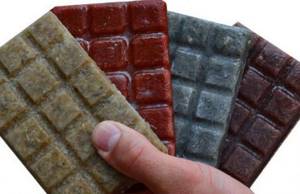
There are only two components:
- bloodworm (mormysh, earthworm);
- sand.
Wet sand is mixed with bloodworms in a volume ratio of 3:1 or 2:1, and packaged in small molds, about 5 x 5 cm. All this is frozen and stored in the freezer. In this form, bloodworms can persist for up to a year.

Before fishing, frozen briquettes are transferred to plastic bags. When fishing, such a briquette is thrown into the hole. The fish sees the bloodworm and eats it as it thaws, but cannot eat it all at once and sticks to the bait. This works especially well in currents, where an ordinary, thrown bloodworm is immediately washed away over a large space from the hole.
Stones
Yes, stones. Ordinary pebbles or river pebbles of medium size, about 5 cm. They operate as follows. If fishing is carried out in a place with a relatively flat, uniform bottom, 5-10 stones are thrown into the hole at the very beginning. Having fallen, firstly, they raise turbidity, and most importantly, they create a conspicuous object on a homogeneous bottom, which the bream will definitely be interested in in search of food. Well, then you can use regular bait.
How to cook porridge correctly
From several cereals
In addition to knowing the tastes of fish, it is important to know the basics of how to cook porridge for bream fishing. To cook a mixture of cereals, first pour 3 cups of water into a saucepan, cover with a lid and wait until it boils. As soon as the water boils, you need to add 2 cups of pearl barley (the amount of water and pearl barley can be changed in accordance with these proportions), mix well and cook until the barley swells. Add a little oil and flavoring (vanillin, cinnamon, coriander, etc.).
After this you need to add 1 cup of millet cereal. When the millet has absorbed most of the water (it will take up almost the entire volume of the pan), turn off the stove, cover the container with a lid and wait half an hour so that the millet “reaches”, that is, takes on a looser consistency, absorbing the remaining water.
Homemade bream food does not contain semolina or other grains that create “dirty”, i.e. small particles. Mud attracts small fish, bream is a large fish. So if you do not set out to feed the inhabitants of a smaller reservoir, prepare bait from ingredients of large fractions.
If there is 1 type of cereal available
Read: Preparing pearl barley for fishing
Flavors
For effective bream fishing, porridge must contain not only nutrients, the bait needs the addition of aromatic substances. In addition to seasonings such as cinnamon, coriander, vanillin, etc., anise, strawberry, fruit and sweet flavors can be used as aromatic agents when preparing millet bait for fishing. You can purchase them both in specialized fishing stores and in regular grocery stores. Here, for example.
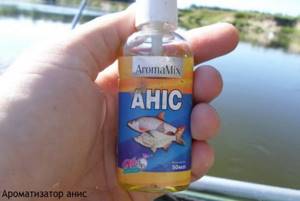
Feeding bream with a feeder
Bream is a very cautious and extremely agile fish, so if it is the main target for fishing, the fisherman will have to show a lot of imagination and use the accumulated experience wisely. An excellent bite has been observed since the end of April.
Pre-selected bait is placed in the feeder feeder; it is best if it is prepared with your own hands, since in this case all the ingredients will be carefully selected and well grouped. The feeder equipment must be specially equipped with hooks that will allow you to pick up the bait.
How to catch more fish? I have been active fishing for quite some time and have found many ways to improve the bite. And here are the most effective ones: Bite activator.
Attracts fish to cold, warm water with the help of pheromones included in the composition and stimulates its appetite. It’s a pity that Rosprirodnadzor wants to ban its sale.
More sensitive gear. Reviews and instructions for other types of gear can be found on the pages of my website.
Lures using pheromones. You can get the rest of the secrets of successful fishing for free by reading my other materials on the site.
Not every fisherman prefers to fish with a float rod; this is how true feeder connoisseurs come across. Any tactic loses its position without the right bait. So, when feeder fishing, it is necessary to use mixtures that include large and crushed particles of food.
It is best to choose for cooking:
- Peas;
- Millet;
- Corn;
- Barley;
- Animal bait.
When the current is active, it is best to choose bulky reels whose weight varies from 90 grams. Skill will also be required when sending them into the water, so you should throw them at a relatively small angle, strictly against the current.
It is best to orient yourself towards the opposite shore. So, it is important that the bait falls on the same place, since it is necessary to lure the fish and force it to settle firmly near the baited bottom.
How to properly store homemade bait
It is best to prepare bait directly at the fishing spot. To do this, you need to prepare the ingredients at home, mix them on the shore and start feeding. It is better to make preparations at once, since the mixture cannot be stored for long periods of time, especially bait with live maggots and other components of animal origin.
Store-bought mixtures, as a rule, consist of dry products and do not require special storage conditions. It is enough not to leave them in open light and at high temperatures.
If, when preparing homemade bait, you are left with a preparation in the form of boiled cereal, then it should be stored in the refrigerator for no longer than a week. Dry mixtures can be stored for a long time in a place isolated from light and moisture.
Advantages of homemade baits
When choosing between mixture and homemade bait, you need to turn to your own preferences. By choosing a ready-made mixture, the fisherman will spend less time on the process of preparing complementary foods, but the result will be lower. Ready-made mixtures consist mainly of dry ingredients, such as feed, which are less attractive to fish than freshly prepared food.
Making the mixture yourself allows you to control the quantity and quality of ingredients, the properties of the final product, consistency and other parameters. In addition, many fishermen note that they receive incomparably greater pleasure from the process of making their own mixture.
